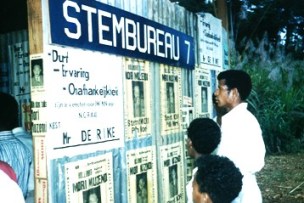 On 5 April 1961 the New Guinea Council (Nieuw-Guinea Raad) was set up. It was an important moment during a period (1959-1962) in which a more democratic mode of administration started to develop within the Dutch colony. Besides the New Guinea Council, regional councils were also elected, which acted as "subdivisions". These regional councils formed a link between the village councils and the New Guinea Council. In 1961 the Dafonsoro Regional Council, named after the highest peak in the area of the former subsection Hollandia, was set up. From that time on this area, with the exception of Hollandia city itself, was governed by the Dafonsoro Regional Council. This particular regional council acted as a model for similar regional councils across former Dutch New Guinea. The elected regional councils governed already existing local communities.
On 5 April 1961 the New Guinea Council (Nieuw-Guinea Raad) was set up. It was an important moment during a period (1959-1962) in which a more democratic mode of administration started to develop within the Dutch colony. Besides the New Guinea Council, regional councils were also elected, which acted as "subdivisions". These regional councils formed a link between the village councils and the New Guinea Council. In 1961 the Dafonsoro Regional Council, named after the highest peak in the area of the former subsection Hollandia, was set up. From that time on this area, with the exception of Hollandia city itself, was governed by the Dafonsoro Regional Council. This particular regional council acted as a model for similar regional councils across former Dutch New Guinea. The elected regional councils governed already existing local communities.
Content:
1. Founding the regional councils
2. The Dafonsoro Regional Community
3. Previous experiments with advisory councils
4. Local advice on how to set up local village communities
5. Training local community councils in (former) Australian Papua New Guinea
6. The first regional council in 1959: Biak-Noemfoor
7. Links
8. Sources
1. Founding the regional councils
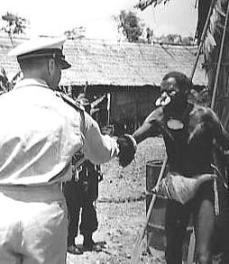 Shaping and developing democratic structures in former Dutch New Guinea was actualised between 1959-1962, the administration period of governor Dr P.J. Platteel (the third and last governor of Dutch New Guinea). The establishment of regional councils came from the requirement that the Charter of the United Nations imposed on the Netherlands: that the interests of the inhabitants of Dutch New Guinea had to be paramount. The Netherlands was to respect the right to self-rule and had to take the political aspirations of the indigenous people into account. They were also meant to support the Papuan people with the gradual development of their own political institutions. The realization of these principles, which had to be reported on to the United Nations on a yearly basis, was no easy task. This was especially so in the early years due to insufficient knowledge of and insight on the Papuan way of life. The situation at that time lacked the basic conditions for democratic governance.
Shaping and developing democratic structures in former Dutch New Guinea was actualised between 1959-1962, the administration period of governor Dr P.J. Platteel (the third and last governor of Dutch New Guinea). The establishment of regional councils came from the requirement that the Charter of the United Nations imposed on the Netherlands: that the interests of the inhabitants of Dutch New Guinea had to be paramount. The Netherlands was to respect the right to self-rule and had to take the political aspirations of the indigenous people into account. They were also meant to support the Papuan people with the gradual development of their own political institutions. The realization of these principles, which had to be reported on to the United Nations on a yearly basis, was no easy task. This was especially so in the early years due to insufficient knowledge of and insight on the Papuan way of life. The situation at that time lacked the basic conditions for democratic governance.
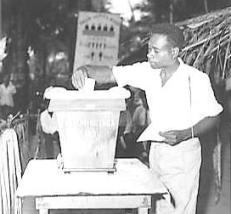 The desirability of regional councils had already been advocated in 1953 by various committees and advisory boards. The Council for National Education, an advisory Committee of the government, was in favour of the establishment of 'local regional communities','and the combining and integration of existing genealogical sub-groups’ , ‘in order to promote active learning of indigenous peoples on a social, economic and cultural front 'and ' in order to achieve an efficient government policy'. The establishment of regional councils was also advocated by an interdepartmental committee report prepared in The Hague on the future development of New Guinea.
The desirability of regional councils had already been advocated in 1953 by various committees and advisory boards. The Council for National Education, an advisory Committee of the government, was in favour of the establishment of 'local regional communities','and the combining and integration of existing genealogical sub-groups’ , ‘in order to promote active learning of indigenous peoples on a social, economic and cultural front 'and ' in order to achieve an efficient government policy'. The establishment of regional councils was also advocated by an interdepartmental committee report prepared in The Hague on the future development of New Guinea.
2. The Dafonsoro regional community
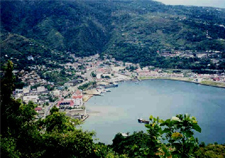 The subdivision Hollandia was one of four subdivisions within the overall division of Northern New Guinea (later referred to as 'Hollandia') and it consisted of three districts:
The subdivision Hollandia was one of four subdivisions within the overall division of Northern New Guinea (later referred to as 'Hollandia') and it consisted of three districts:
- Tobati, in which the city of Hollandia was situated
- Sentani around the Sentanimeer
- Depapre at Tanah Merah Bay
In the years after World War II, this subdivision was extended, but at a later stage the southern end of it was converted to form a new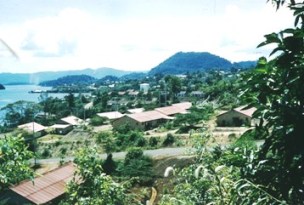 subsection, Keerom, and parts on the western side were attached to the subdivision Nimboran. What remained was a fairly densely populated area by New Guinean standards. It had a surface area of around 1500 km2 with a population of at least 15000 residents, who lived in 62 villages. Much of the area consisted of water (Lake Sentani and a number of other lakes) and mountains (the Cyclops Mountains with its highest peak, the Dafonsoro). The urban area of Hollandia, which also had over 15,000 inhabitants, was not included in the regional community that had now been established.
subsection, Keerom, and parts on the western side were attached to the subdivision Nimboran. What remained was a fairly densely populated area by New Guinean standards. It had a surface area of around 1500 km2 with a population of at least 15000 residents, who lived in 62 villages. Much of the area consisted of water (Lake Sentani and a number of other lakes) and mountains (the Cyclops Mountains with its highest peak, the Dafonsoro). The urban area of Hollandia, which also had over 15,000 inhabitants, was not included in the regional community that had now been established.
3. Previous experiments with advisory councils
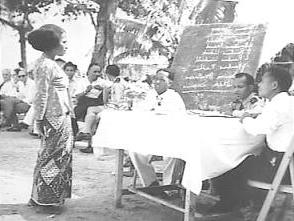 A period of trial and error preceded the democratization process initiated in 1959. In 1948, at the initiative of the government official Dr. JV de Bruyn in the Biak, 'Kankain Kankara Biak' was created, an advisory board, which consisted of a group of clan chiefs. After World War II, the Netherlands and Indonesia could not agree on the fate of New Guinea and as a result it continued to be a Dutch colony. In 1950, after the independence of Indonesia, it became necessary to devise a new system of governance for Dutch New Guinea. It was announced that a representative body for the whole of Dutch New Guinea was to be formed and that a series of independent advisory committees and communities were to be established at the local level.
A period of trial and error preceded the democratization process initiated in 1959. In 1948, at the initiative of the government official Dr. JV de Bruyn in the Biak, 'Kankain Kankara Biak' was created, an advisory board, which consisted of a group of clan chiefs. After World War II, the Netherlands and Indonesia could not agree on the fate of New Guinea and as a result it continued to be a Dutch colony. In 1950, after the independence of Indonesia, it became necessary to devise a new system of governance for Dutch New Guinea. It was announced that a representative body for the whole of Dutch New Guinea was to be formed and that a series of independent advisory committees and communities were to be established at the local level.
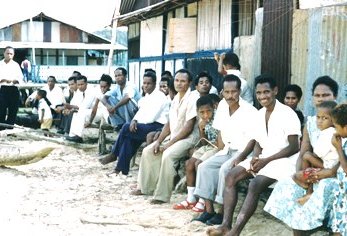 In the subsequent year, 1951, advisory committees were established in the northern, western and southern parts of New Guinea but these did not really function at all. Some of the advisory committees, the majority of which consisted of Papuans, did actually hold one or two meetings in 1952, but that was all. An important reason for the malfunctioning of these councils was that the administrative jurisdictions were only administrative departments and they did not reflect the actual divisions of the communities living in each region. A few other areas also experimented with advisory councils. It cannot be said that these efforts had much success within the social structure of New Guinea with its many small towns and the absence of its own umbrella associations.
In the subsequent year, 1951, advisory committees were established in the northern, western and southern parts of New Guinea but these did not really function at all. Some of the advisory committees, the majority of which consisted of Papuans, did actually hold one or two meetings in 1952, but that was all. An important reason for the malfunctioning of these councils was that the administrative jurisdictions were only administrative departments and they did not reflect the actual divisions of the communities living in each region. A few other areas also experimented with advisory councils. It cannot be said that these efforts had much success within the social structure of New Guinea with its many small towns and the absence of its own umbrella associations.
4. Local advice on how to set up local village communities
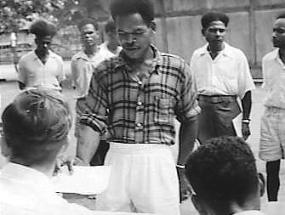 In some areas, such as in the districts of Soepiori, Noord-Biak, Zuid-Biak and Bosnik within the subdivisions of Schouteneiland and Japen, advisory committees were established by the Dutch civil service to ensure that the process of democratisation was put in place. Their primary task was to provide advice on the following two aspects:
In some areas, such as in the districts of Soepiori, Noord-Biak, Zuid-Biak and Bosnik within the subdivisions of Schouteneiland and Japen, advisory committees were established by the Dutch civil service to ensure that the process of democratisation was put in place. Their primary task was to provide advice on the following two aspects:
- The organization of (larger) local village communities, including the establishment of their management structures;
- The formation of an autonomous community for (part of) the subdivision in question. This autonomous community was to address the composition of a governing council, the election or appointment of its members, the activities with which the community could be ordered and their own funding needs. 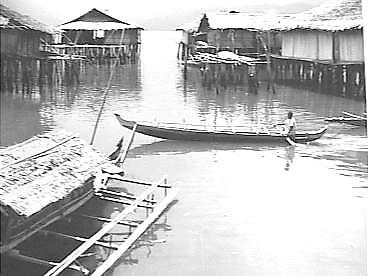 Eventually advice was forth-coming. For example, in May 1956 the "Dewan Penasihat Sementara Biak-Supiori" (Interim Advisory Biak-Supiori) brought out a report which contained valuable building blocks for the design of local village communities. Within the advisory council for Japan, the establishment of a regional committee consisting of village communities resulted in extensive community consultation. The towns of Hollandia, Manokwari and Sorong-Doom also set up advisory councils which were to give advice on the establishment of autonomous communities for each of these urban centres.
Eventually advice was forth-coming. For example, in May 1956 the "Dewan Penasihat Sementara Biak-Supiori" (Interim Advisory Biak-Supiori) brought out a report which contained valuable building blocks for the design of local village communities. Within the advisory council for Japan, the establishment of a regional committee consisting of village communities resulted in extensive community consultation. The towns of Hollandia, Manokwari and Sorong-Doom also set up advisory councils which were to give advice on the establishment of autonomous communities for each of these urban centres.
5. Learning from local community councils in (former) Australian Papua New Guinea
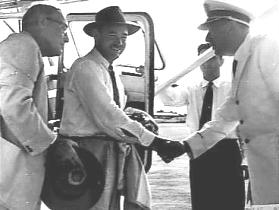 In shaping local communities, run by local councils, use was made of relevant experiences in Australian New Guinea. This was a consequence of the joint declaration signed by Australia and The Netherlands in Canberra on 6 November 1957. This declaration announced a greater administrative cooperation between the two countries in the development of the two halves of New Guinea. Shortly after, in that same month of November 1957, the then Governor Jan van Baal (governor number 2 in Dutch New Guinea) visited Australian New Guinea (later known as Papua New Guinea). The Village councils (as they were named initially) in Australian New Guinea turned out to be district councils rather than village councils and they mainly dealt with promoting the material interests of the residents. For example, encouraging self-reliance of the indigenous population by persuasion and legal pressure had impressive results, especially in the areas of road construction and the introduction of new crops such as cocoa and coffee. Van Baal was struck by the simplicity of the approach of the Australian government and wanted to apply their methods for development planning in the Dutch part. He emphasised that as part of this planning, the autonomy of the indigenous people come first.
In shaping local communities, run by local councils, use was made of relevant experiences in Australian New Guinea. This was a consequence of the joint declaration signed by Australia and The Netherlands in Canberra on 6 November 1957. This declaration announced a greater administrative cooperation between the two countries in the development of the two halves of New Guinea. Shortly after, in that same month of November 1957, the then Governor Jan van Baal (governor number 2 in Dutch New Guinea) visited Australian New Guinea (later known as Papua New Guinea). The Village councils (as they were named initially) in Australian New Guinea turned out to be district councils rather than village councils and they mainly dealt with promoting the material interests of the residents. For example, encouraging self-reliance of the indigenous population by persuasion and legal pressure had impressive results, especially in the areas of road construction and the introduction of new crops such as cocoa and coffee. Van Baal was struck by the simplicity of the approach of the Australian government and wanted to apply their methods for development planning in the Dutch part. He emphasised that as part of this planning, the autonomy of the indigenous people come first.
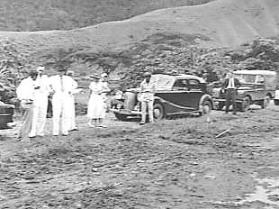 Subsequently, In March 1958, the resident H.Veldkamp of the Gelvinkbaai paid a follow-up visit to the Australian territory of Papua New Guinea.Several Papua members of the advice committee from Schouteneiland and Japan accompanied him on this visit. Veldkamp and his team were also very much impressed by what they saw. At the same time they were critical and Veldkamp indicated that the revised name of the councils ( ‘Native Local Government Councils’ ) were run for and by natives, meaning only papuans. According to his way of thinking, this would not be the case for the regional and village councils to be set up in Dutch New Guinea. Not only the Papuans but all the residents of a particular area should be involved including Indonesians, Chinese and the Dutch.Veldkamp also noted the high degree of tutelage by the Australian Government: In reality the councils had very restricted powers. Almost everything was
Subsequently, In March 1958, the resident H.Veldkamp of the Gelvinkbaai paid a follow-up visit to the Australian territory of Papua New Guinea.Several Papua members of the advice committee from Schouteneiland and Japan accompanied him on this visit. Veldkamp and his team were also very much impressed by what they saw. At the same time they were critical and Veldkamp indicated that the revised name of the councils ( ‘Native Local Government Councils’ ) were run for and by natives, meaning only papuans. According to his way of thinking, this would not be the case for the regional and village councils to be set up in Dutch New Guinea. Not only the Papuans but all the residents of a particular area should be involved including Indonesians, Chinese and the Dutch.Veldkamp also noted the high degree of tutelage by the Australian Government: In reality the councils had very restricted powers. Almost everything was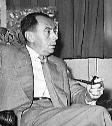 subject to the supervision or approval by the Australian government officials. Nevertheless, one could learn much from the operation.
subject to the supervision or approval by the Australian government officials. Nevertheless, one could learn much from the operation.
At the beginning of 1957 during his stay in Netherlands, the minister told Verbaal that the cabinet wanted to see a number of independent communities as soon as possible. The experimental phase with councils that only had an advisory role definitely belonged to the past.
6. The first regional council in 1959: Biak-Noemfoor
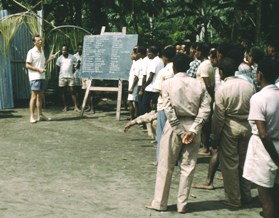 Biak was well ahead with setting up its regional council. An experiment in two districts with several villages from existing local communities, had gone favourably. This had the result that in the course of 1957-1958, sixteen of these village communities were formed which together just about equalled the total territory of the subsection of Schouten Islands. As it should be, the organisational structure was started from the bottom up: by firstly working with five elected village councils each consisting of five to nine members, and then with the regional council directly above them. Later, the reverse was often the case: the regional council was set up first, and the village councils came next. This was mainly due to the haste, for political reasons, with which the regional councils needed to be set up subsequently.
Biak was well ahead with setting up its regional council. An experiment in two districts with several villages from existing local communities, had gone favourably. This had the result that in the course of 1957-1958, sixteen of these village communities were formed which together just about equalled the total territory of the subsection of Schouten Islands. As it should be, the organisational structure was started from the bottom up: by firstly working with five elected village councils each consisting of five to nine members, and then with the regional council directly above them. Later, the reverse was often the case: the regional council was set up first, and the village councils came next. This was mainly due to the haste, for political reasons, with which the regional councils needed to be set up subsequently. 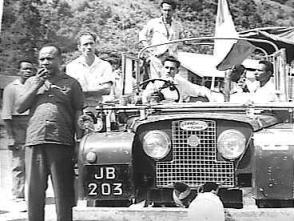
In 1958 the time was right for establishing a set of policies that would form the basis of the necessary legislation to establish local, independent communities with their own funds. This was done using a concept outlined in a paper ('Nota dorpsvonning en dorpsraden; lokale raden en decentralisatie') by van Baal, 24 February 1958, on the formation of village communities and local councils and on the process of decentralisation. This concept took definite shape after discussion during a series of conferences by local residents, and a board consisting of government department heads. The new policy was actually a continuation of the development begun in 1955 by Van Baal in a paper (‘Enige beschouwingen over de instelling van raden op Nederlands Nieuw-Guinea’) on the establishment of councils in Dutch New Guinea in which he pleaded that the Councils had to take on independent tasks and that this was to be seen as a transition stage to establishing independent communities with their own decision-making powers and own funds to act as they saw fit.
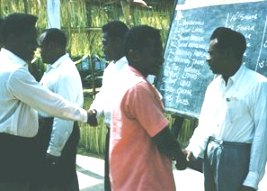 In 1959 everything was ready to go: A regional council was officially put in place by ordinance. This first regional council was governed by a board consisting of ten members, chosen through indirect election, and three members that had been appointed. The turnout for the election was high. The idea of their own administrative representation had clearly taken hold and this success was in part due to an intensive information campaign before the election. The regional council had the task of regulating and governing its own affairs. It was able to adopt regulations and determine taxes and it had its own funds. The Board installed 18 local committees which were to oversee the community councils that were set up within the Biak-Noemfoor Region.
In 1959 everything was ready to go: A regional council was officially put in place by ordinance. This first regional council was governed by a board consisting of ten members, chosen through indirect election, and three members that had been appointed. The turnout for the election was high. The idea of their own administrative representation had clearly taken hold and this success was in part due to an intensive information campaign before the election. The regional council had the task of regulating and governing its own affairs. It was able to adopt regulations and determine taxes and it had its own funds. The Board installed 18 local committees which were to oversee the community councils that were set up within the Biak-Noemfoor Region.
7. Links
- Work Travel Journal to Austalian New Guinea by Van Baal ( 20-111957) pdf
- Elections of the Biak-Noemfoor Regional Counsil (10-9-1959) pdf
- Notes by Bots, the secretary of state, about democratising the councils (16-6-1960) pdf
- First meeting of the New Guinea Board of Papuans appointed to learn about governing their own country which was at that time to become independent) on 5 April 1961
- West New Guinea resolution about self-gouvernance bij de Biak-Noemfoor Regional Counsil (7-6-1963) pdf
- Video: Nieuw Guinea Kroniek 21: De Weg naar Zelfbeschikking (The road to self-governance) Multifilm, 1961(in colour)
8. Sources
- Advice and Information by Frans Peters
- Baal, J. Van, Nota Dorpsraden, 5 juli 1955, Nota Adviserende Raden, 11 juli 1955, Nota Dorpsraden, 25 mei 1956, Zelfstandige gemeenschappen in de zin van art. 122 Bewindsregeling Nieuw-Guinea (verslag bespreking), (ontwerp-) Nota Dorpsvorming en Dorpsraden; Locale Raden en Decentralisatie van 24 febr. 1958.
- Baal, J. van, Ontglipt verleden; Verhaal van mijn leven in een wereld die voorbijging; II. Leven in verandering 1947-1958. Van Wijnen Franeker; 1989.
- Drooglever, P.J . Een daad van vrije keuze, De Papoea's van Westelijk Nieuw-Guinea en de grenzen van het zelfbeschikkingsrecht, Boom Amsterdam 2005.
- Dubois, J.J.W., Memorie van Overgave van de onderafdeling Hollandia, periode sept. 1960 - aug. 1961; Hollandia 1961.
- Galis, K.W., Papua's van de Humboldtbaai, Bijdrage tot een ethnografie; J.N. Voorhoeve Den Haag 1955.
- Interdep. Commissie, Toekomstige ontwikkeling van Nieuw-Guinea , Staatsdrukkerij en Uitgeverijbedrijf 's Gravenhage 1953.
- Koning, D.A.P., Eenige gegevens omtrent land en volk der Noord-Oostkust van Ned. Nieuw-Guinea, genaamd Papoea Telandjang. Ontleend aan het rapport van D.A.P. Koning (commandant Hr.Ms. Ceram). Bijdr. Taal-, Land- en Volkenkunde van N.I., 's Gravenhage 1903.
- Lagerberg, C.S.I.J, Jaren van Reconstructie; Nieuw-Guinea van 1949 tot 1961; Zuid--Nederlandsche Drukkerij N.V. 's Hertogenbosch 1962.
- Schoorl, J.W., Besturen in Nederlands Nieuw-Guinea 1945, onder redactie van Pim Schoorl; Ontwikkelingswerk in een periode van politieke onrust; KITLV Uitgeverij Leiden 1996.
- Voorlichtingsbrochure Information brochure) Streekraad / Dewan Daerah, Bevolkingsvoorlichting Hollandia 1961.